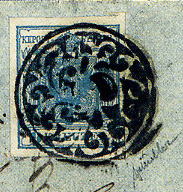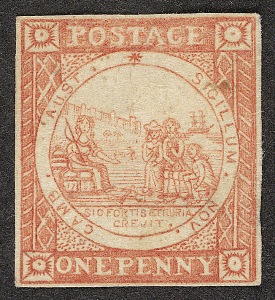This article needs additional citations for verification .(April 2014) |
Postage stamp reuse is the technique of fraudulently reusing postage stamps from sent mail to avoid paying the cost of postage.
This article needs additional citations for verification .(April 2014) |
Postage stamp reuse is the technique of fraudulently reusing postage stamps from sent mail to avoid paying the cost of postage.
A postage stamp is a small piece of paper attached to mail that indicates that the postage (the cost of sending the mail) has been paid. Because stamps are sent on most mail, the stamp on a received item can be removed and placed on a different piece of mail to be sent, thus reusing the stamp without paying the proper postage.
In many countries, such as the United States, reuse of used stamps, whether cancelled or not, is illegal. [1] [2]
After use, many stamps are marked with a cancellation by the postal system, which defaces the stamp and prevents its reuse. The cancellation usually includes a killer placed on the stamp that has black bars, cork impressions or other obstructive shapes to deface the stamp. Instead of using an entirely separate mark, some countries use their postmark, placed on the stamp, to cancel mail.

In the United States, the experiment of grilling was tried in 1867, where tiny squares were embossed into the paper after the stamp was printed, the idea being that this would break up the paper fibers and let more ink be absorbed into the paper. Grilling was abandoned around 1871 due to the stamps being more likely to tear. Unusual types of grills are typically found on rare U.S. stamps. [3]
In the 1880s in Great Britain, the use of inks which were water-soluble, thus preventing successful washing, was used. Only lilac and green colors were available. This scheme was abandoned after a few years, and the few surviving unwashed stamps have become collectibles.
Later experiments involved surface coatings. Between 1901 and 1907 Austria applied varnish bars, thin diagonal strips of varnish, to the paper before printing the design. Russia did the same between 1909 and 1915, applying the varnish in a pattern of lozenges. In both cases the theory was the same; the ink of the printed design would not soak into the varnish, so that in the washing process the design would tend to flake off, forming a telltale pattern on the washed stamp. The United States also coated a few of their $1 revenue stamps with varnish around the turn of the 20th century.
A perfin is a stamp that has had initials or a name perforated across it to discourage theft. By agreement with postal authorities, a perfin stamp on a letter could be used only by the owner of the perfin. Therefore, a stolen perforated stamp would be of no value to the unauthorized bearer.
More unusual methods have included tearing or slicing the stamp, but this is a slower process and can easily damage the contents, and was only occasionally used. An example is 19th century Afghanistan, where cancellation involved the removal of part of the stamp rather than applying ink or other surface marking.

Philately is the study of postage stamps and postal history. It also refers to the collection and appreciation of stamps and other philatelic products. Philately involves more than just stamp collecting or the study of postage; it is possible to be a philatelist without owning any stamps. For instance, the stamps being studied may be very rare or reside only in museums.

A postage stamp is a small piece of paper issued by a post office, postal administration, or other authorized vendors to customers who pay postage. Then the stamp is affixed to the face or address-side of any item of mail—an envelope or other postal cover —which they wish to send. The item is then processed by the postal system, where a postmark or cancellation mark—in modern usage indicating date and point of origin of mailing—is applied to the stamp and its left and right sides to prevent its reuse. Next the item is delivered to its addressee.

A postmark is a postal marking made on an envelope, parcel, postcard or the like, indicating the place, date and time that the item was delivered into the care of a postal service, or sometimes indicating where and when received or in transit. Modern postmarks are often applied simultaneously with the cancellation or killer that marks postage stamps as having been used. Sometimes a postmark alone is used to cancel stamps, and the two terms are often used interchangeably. Postmarks may be applied by handstamp or machine, using methods such as rollers or inkjets, while digital postmarks are a recent innovation.

A cancellation is a postal marking applied on a postage stamp or postal stationery to deface the stamp and to prevent its reuse. Cancellations come in a huge variety of designs, shapes, sizes, and colors. Modern cancellations commonly include the date and post office location where the stamps were mailed, in addition to lines or bars designed to cover the stamp itself. The term "postmark" refers specifically to the part that contains the date and posting location, but the term is often used interchangeably with "cancellation" as it may serve that purpose. The portion of a cancellation that is designed to deface the stamp and does not contain writing is also called the "obliteration" or killer. Some stamps are issued pre-cancelled with a printed or stamped cancellation and do not need to have a cancellation added. Cancellations can affect the value of stamps to collectors, positively or negatively. Cancellations of some countries have been extensively studied by philatelists, and many stamp collectors and postal history collectors collect cancellations in addition to the stamps themselves.

An overprint is an additional layer of text or graphics added to the face of a postage or revenue stamp, postal stationery, banknote or ticket after it has been printed. Post offices most often use overprints for internal administrative purposes such as accounting but they are also employed in public mail. Well-recognized varieties include commemorative overprints which are produced for their public appeal and command significant interest in the field of philately.

For postage stamps, separation is the means by which individual stamps are made easily detachable from each other.
This is a list of philatelic topics.

A fancy cancel is a postal cancellation that includes an artistic design. Although the term may be used of modern machine cancellations that include artwork, it primarily refers to the designs carved in cork and used in 19th century post offices of the United States.

This is a survey of the postage stamps and postal history of New South Wales, a former British colony now part of Australia.

In philately, a perfin is a stamp that has had initials or a name perforated across it to discourage theft. The name is a contraction of perforated initials or perforated insignia. They are also sometimes called SPIFS.

A revenue stamp, tax stamp, duty stamp or fiscal stamp is a (usually) adhesive label used to designate collected taxes or fees on documents, tobacco, alcoholic drinks, drugs and medicines, playing cards, hunting licenses, firearm registration, and many other things. Typically, businesses purchase the stamps from the government, and attach them to taxed items as part of putting the items on sale, or in the case of documents, as part of filling out the form.

A grill on a postage stamp is an embossed pattern of small indentations intended to discourage postage stamp reuse. Used in the United States in the 1860s and 1870s, they were designed to allow the ink of the cancellation to be absorbed more readily by the fibres of the stamp paper, making it harder to wash off the cancellation.

The Benjamin Franklin Z Grill, or simply "Z-Grill", is a 1-cent postage stamp issued by the United States Postal Service in February 1868 depicting Benjamin Franklin. While stamps of this design were the common 1-cent stamps of the 1860s, the Z-Grill is distinguished by having the so-called "Z" variety of a grill pressed into the stamp, creating tiny indentations in the paper. Although the 1-cent Franklin Z-Grill is generally cited as the rarest and most valuable of all US postage stamps, the 15-cent Lincoln Z-Grill is just as rare, also with only 2 known to exist. The 10-cent Washington Z-Grill scarcely less rare with only 6 known to exist. First production runs of Z-Grill process were made of the common Z-grill denominations - the 2-cent Jackson, 3-cent Washington, and 12-cent Washington stamps. The earliest known postmarks of these Z-grill stamps date from January 1868. Then in February 1968 three other denominations were printed with the Z. Grill, the above mentioned 1-cent Franklin, 10-cent Washington and 15-cent Lincoln stamps. These three denominations were only in production for a short period of time with only about 1000 of each being printed before production shifted to the F-grill - resulting in the rarity of these 3 stamps.

The Hawaiian Missionaries are the first postage stamps of the Kingdom of Hawaii, issued in 1851. They came to be known as the "Missionaries" because they were primarily found on the correspondence of missionaries working in the Hawaiian Islands. Only a handful of these stamps have survived to the present day, and so they are amongst the great rarities of philately.

In general, philatelic fakes and forgeries are labels that look like postage stamps but have been produced to deceive or defraud. Learning to identify these can be a challenging branch of philately.
Postage stamps and postal history of Baden refers to the postal history and postage stamps of the German state of Baden from 1851 to 1871.

The postal history of Turkey and its predecessor state, the Ottoman Empire, dates to the 18th century when foreign countries maintained courier services through their consular offices in the Empire. Although delayed in the development of its own postal service, in 1863 the Ottoman Empire became the second independent country in Asia to issue adhesive postage stamps, and in 1875, it became a founding member of the General Postal Union, soon to become the Universal Postal Union. The Ottoman Empire became the Republic of Turkey in 1923, and in the following years, its postal service became more modernized and efficient and its postage stamps expertly designed and manufactured.
The Stamp Specialist is the title of a series of books on philatelic research written and edited for the advanced collector of postage stamps.

Philatelic expertisation is the process whereby an authority is asked to give an opinion whether a philatelic item is genuine and whether it has been repaired or altered in any way.

In philately a fiscal cancel – symbol – is a cancellation on a stamp that indicates that the stamp has been used for fiscal (taxation) purposes.